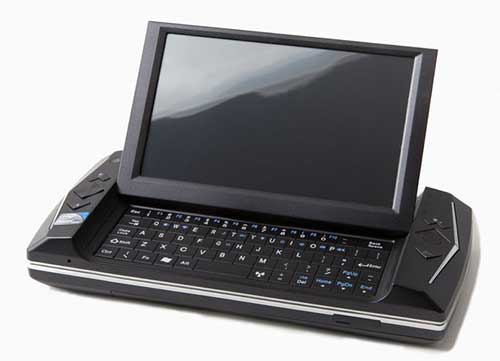
Remember the Sony UX and OQO handheld PCs from several years ago? The Highton MI15 from Dynamism is a fresh new look at pocket PCs. And I’m not referring to the pocket PC PDAs of days gone by, I’m talking about a true PC in your pocket. The Highton runs a full version of Windows 7 Home Premium and is powered by an Intel Atom Z151 1.2GHz CPU with 1GB of RAM, and a 16GB SSD. It has a 5″ 1024 x 600 pixel touch display and weighs under 1 lb. It even features a 3G (HSPA/UMTS 850/900/1900/2100MHz) radio. The price tag is pretty spendy at $949… Although it looks like an interesting gadget, I think I’ll just keep using my 13″ Macbook Air with the larger display and touch typeable keyboard.



Gadgeteer Comment Policy - Please read before commenting
I still miss my OQO 01. absolutely loved it, and would really again like to see another handheld windows machineagain
I really don’t think that 1Gig RAM would be enough for Win 7…. At that price you’d have to have a good reason to purchase it. Many other devices could do the job for much less. 🙂
By the way, what’s this “perpetual license to reproduce your words and name/web site in attribution” thingy?
Is it new or have I just missed reading it before?
Just wondering 😉
@Bob It’s new… Just a comment policy I’ve added to the site. Basically means that your comments can be reproduced / reprinted, etc. If you click through to the page, you’ll see guidelines on what we do and don’t accept as a valid comment.
Thanks Julie…
Does “appear to be written by a crazy person” apply to me?
🙁
@Bob not yet 😉 Keep it up and we’ll see though.
I wouldn’t call a UMPC from 2010 a “Fresh new look”… Dynamism is mainly a import reseller and this UMPC used to be branded as the Eking E5 UMPC, and the price has gone up since the original import cost was $800 back in 2010.
The Viliv N5 was better but that company went out of business and almost no one makes UMPCs anymore.
Though some China based companies have started to come out with some 7” mini-laptops based on ARM. Won’t run Windows but some of them should be able to run Linux and some may be sold with Windows RT when it comes out.
While for x86 systems we may see some pocket-able devices starting next year when Intel starts pushing out their 22nm ATOM update and start to more aggressively push into the mobile market, along with Windows 8.
What does/can it do better than current tablets and phones….
In my mind it better do things a lot better considering the price and what you can get for much cheaper.
Basically avoid this unless you’re looking for something almost pocket-able that can run Windows and similar OS options.
Performance is less than what you would get with a typical netbook, it’s actually a 2010 product as I mentioned before. The CPU is actually a Z515…
Z-Series ATOMs in general are under performing because they are more highly optimized for lower thermals and lower power consumption than other ATOM series and often get applied to small devices and embedded systems.
Price is mainly high because it’s a import, they tend to be higher priced than the normal going rate, and because of the 3G. While since this is not something regularly sold anymore, they could also be charging for the rarity of anything similar still being sold anywhere.
Most modern netbooks actually sell below $300 now, with one or two actually reaching the $200 mark. While for over $900 you could just get a Ultrabook for way, way, way more performance than this thing would provide.
Since you asked about Phones and Tablets… ARM devices in general are still lower performing than even Intel ATOM’s, not that it matters as running mobile OS and apps is a lot easier than running desktop OS and desktop apps. So only a issue if you need to run desktop software like MS Office or otherwise need much more powerful devices.
It’s just the upcoming Windows 8 will offer a Windows RT version that can run on ARM that’s making people wonder what they can start using their ARM devices for, along with similar efforts to port some Linux distros as well, but it’s just the next gen ARM chips coming out now and through to next year that actually have managed to rival the Intel ATOM for performance and finally offer the kind of performance to run netbook range desktop OS and software but even those are still a long way from providing the kind of performance that even a low end ULV Core i-series Intel chip can provide.
The lack of legacy support for older Windows software on ARM may limit such a shift in focus though and they may remain dominantly with the traditional mobile OS and apps.
While Intel is trying to get into the mobile market, ARM has until next year before Intel comes out with its own next gen updates and we’ll see then which will offer the best for where in the market they’re now starting to overlap.
@James you summed it up very well. I’ve been keeping my eye on the ARM multicore processors: scalability of 1 to 4 cores, and where the future is going (laptops running Android). I feel that Intel and Microsoft better get their act together and soon… maybe it really doesn’t matter anymore, they are out of the picture, as Android matures and gets more functional, everybody gets used to working with the OS and has access to these very affordable devices…
Thanks!